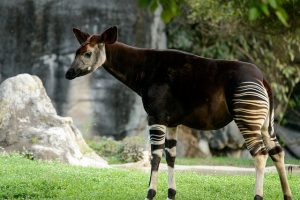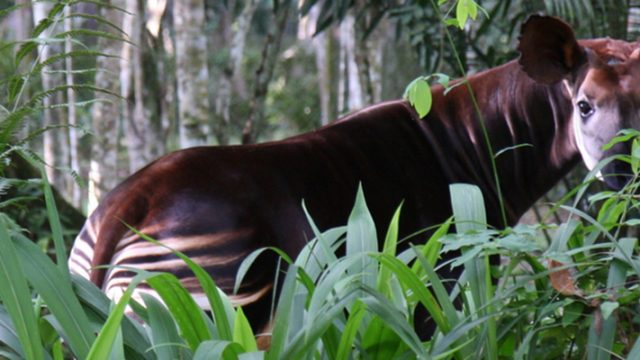Hailed as “the Unicorn of Africa,” the Okapi remains as a celebrated animal in the Democratic Republic of the Congo. A quick glance at the odd-looking creature will have anyone scratching their heads and questioning if they’ve stumbled upon a hybrid creature. They are recognized by their iconic zebra-like striped patterns on their buttocks and broad heads that resemble a giraffe’s. But stick around for awhile and you’ll notice the incredibly-long dark blue-ish tongues slithering out of their mouths. But are they truly a hybrid and are they on the edge of extinction? And how does this exotic creature stay unknown to the rest of the population outside of the Congo, despite its striking appeal? I contacted Lucas Meers, a program officer at the Okapi Conservation Project in Jacksonville, Florida to find out all about it.
AB: Why the okapi?

Courtesy of Eric Kilby/Flickr.com
LM: The okapi is a well-respected animal in the Democratic Republic of the Congo and is embedded into their culture. The image of the okapi is found on their money and their name is used on many types of products in the country — water, gum, cigarettes and even their nation-wide radio station is called “Radio Okapi.” Even though it’s a protected animal since 1933, there were no measures in place to ensure it remained protected. That its habitat and the other animals that live within it are protected, which is why we started the project in 1987.
AB: What would happen if they went extinct?
LM: The world would lose a significant cultural symbol. Okapi are rarely poached themselves, but we are seeing anecdotal evidence that it’s happening. Snares and traps meant for other animals can easily entangle and kill okapi. And the presence of humans scares the okapi away. Deforestation and gold mining are a major threat to them.
AB: I assumed because of their unique fur pattern, they’d be hunted.
LM: Not so much. Occasionally we’ll see drums or chairs made out of their hides, but it doesn’t really occur much to our knowledge. That’s not to say it isn’t happening, we just aren’t seeing much evidence. It goes back to the okapi being so well-respected by the community.
AB: Wow. Interesting.
LM: We call the okapi a ‘flagship species’ and we utilize its image to protect itself and the habitat which other animals live. Because most people respect the animal and appreciate it, they will work to protect its rainforest home and the animals, and plants that share it.
AB: That makes perfect sense. Deforestation is the issue here.

Courtesy of Matthew Bellemare/Flickr.com
LM: Correct. Deforestation is the main issue. And that’s seen through gold mining and slash-and-burn farming.
AB: For our readers who wish to make a donation to your conservation project, can you tell them what the money would be used for?
LM: Conservation is really about ensuring the local community can live comfortable sustainable lives so they don’t impact the forest which okapi live. We have an agroforestry program that teaches farmers sustainable practices to grow crops that don’t impact the forest, but still provide their family with the food and money (from selling the surplus) with what they need. We work with women in the community and provide them with the materials and knowledge to begin their own microenterprises and sell clothes to pay the families’ healthcare costs and their children’s school fees. All donations we collect go toward these projects in and around the community.
AB: I do have to ask — are they hybrids?
LM: Haha — they aren’t! They’re their own species, and their closest living relative is the giraffe.
Click here to learn more and make contributions toward The Okapi Conservation project.
For more great info on the okapi, read our article: 7 Things You Didn’t Know About the Okapi: Africa’s Oddest-Looking Animal

